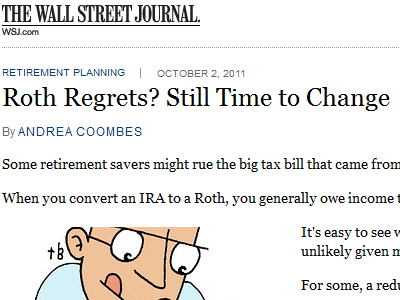Roth Recharaterizations are no longer part of the tax code.
For a description of how this changes this Roth conversion strategy, read “No Roth Recharacterizations After 2017?”

David John Marotta was featured in a Wall Street Journal article by Andrea Coombs online at “Roth Regrets? Still Time to Change.” Here is the section that mentioned David John Marotta directly:
Some financial advisers see the option to recharacterize as an opportunity to boost clients’ after-tax investment returns. David John Marotta, president of Charlottesville, Va.-based Marotta Wealth Management, says for his clients last year he converted about five times the amount of money they said they wanted in a Roth.
For each client, he divided the money into five Roth accounts, each focused on a distinct asset class. The account that performs the best, he’ll keep in a Roth for the tax-free gains. The others he will recharacterize.
And here is another section containing some of the general wisdom about the use of Roths in retirement and estate planning:
You can undo your conversion for any reason, but time is running short for those who converted to a Roth in 2010. The deadline for a do-over is Oct. 17 this year.
More people may be eyeing a do-over, if only because the number of people who converted to a Roth soared in 2010, thanks to new rules that made more people eligible to convert. Before 2010, people with adjusted gross income of more than $100,000 generally couldn’t convert to a Roth. Even today, some high-income taxpayers can’t contribute to a Roth — but they can convert a traditional IRA to a Roth.
Tapping a Roth IRA can be a useful retirement strategy. For one, Roth IRAs help to mitigate your tax burden. You contribute after-tax money but all of your contributions and earnings come out later tax-free, unlike the taxable distributions of most other retirement plans.
Also, unlike a traditional IRA, there are no required minimum distributions at age 70 1/2. Roths also are a useful estate-planning tool: You can leave your Roth to, say, your grandson and he won’t have to start distributions until the year after you die. Distributions are stretched out across his life; meanwhile, the account’s earnings grow tax-free.
Consider using a Roth conversion strategy for your retirement planning.